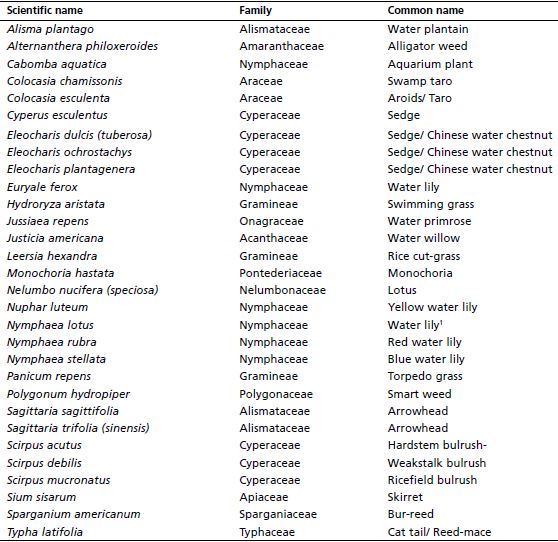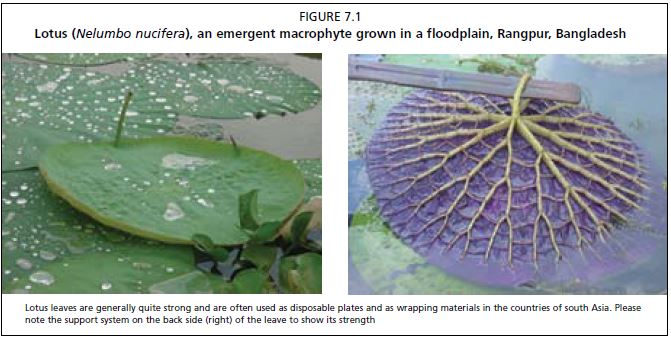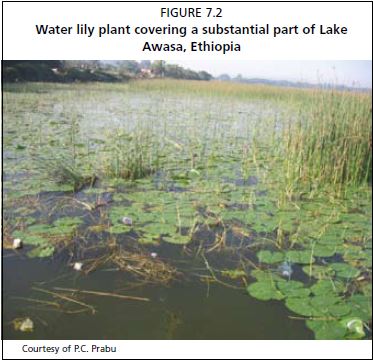7 Emergent aquatic macrophytes
Emergent aquatic macrophytes are defined as plants that are rooted in shallow water with vegetative parts emerging above the water surface. It is thought that emergent macrophytes are the most particularly productive of all aquatic macrophytes since they make the best use of all three possible states—with their roots in sediments beneath water and their photosynthetic parts in the air (Westlake, 1963). Westlake (1966) reported the net yield of emergent macrophytes to range from 35 to 85 tonnes DM/ha/year in fertile ponds.
7.1 Classification
There are many different types of emergent macrophytes commonly found in the shallow stagnant waters of tropical and sub-tropical countries of the world. A list of commonly occurring species is presented in Table 7.1. Most of these macrophytes grow naturally; some, however, are used for human consumption and are cultivated.
Table 7.1
Common and scientific names of commonly occurring emergent aquatic macrophytes Scientific name Family Common name

1 There are many species of water lily (e.g. Nymphaea lotus, N. nouchali, N. stellata, Victoria amazonica, V. cruziana); the most commonly found species is N. lotus
7.2 Characteristics
Arrowhead (Sagittaria spp.) has eight or more underground stems, each with a corm at the end. S. trifolia grows wild or semi-cultivated in swamps throughout tropical and subtropical Asia (Ruskin and Shipley, 1976). It is also widely cultivated in China and
Figure 7.1
Lotus (Nelumbo nucifera), an emergent macrophyte grown in a floodplain, Rangpur, Bangladesh

Lotus leaves are generally quite strong and are often used as disposable plates and as wrapping materials in the countries of south Asia. Please note the support system on the back side (right) of the leave to show its strength
Hong Kong (Herklots, 1972). S. trifolia and other species of arrowheads are cultivated by Chinese people in many other parts of the world (Cook et al., 1974). It is reported to be a serious and widespread weed in many countries. However, since it grows quickly and no special care is needed, it could probably be developed into a useful crop. There are no yield data but it can be harvested after 6-7 months (Ruskin and Shipley, 1976). The corms of the arrowhead are boiled like potatoes and are eaten by Chinese and Japanese people with meat dishes. Sium sisarum is another emergent macrophyte that is cultivated for its edible roots (Cook et al., 1974). These authors also note that taro (Colocasia esculenta) has a starch filled rhizome that is often eaten. Sedge (Cyperus esculentus) is widely cultivated for its edible tubers.
The Chinese water chestnut (Eleocharis dulcis) is an emergent aquatic plant that grows throughout the year. It is an erect stout and slender perennial leafless sedge (Pandey and Srivastava, 1991a). It has corms or tubers,
Figure 7.2
Water lily plant covering a substantial part of Lake Awasa, Ethiopia

Courtesy of P.C. Prabu
which are produced in large quantities on underground rhizomes towards the end of the growing season. The plant is widespread from Madagascar to India, SE Asia, Melanesia and Fiji. Occasionally, it is used as a wild source of food in Java and the Philippines. It is cultivated in China for the high starch content of its tubers. It commonly grows in swamps and shallow waters. The yield was said to be greater than 7 tonnes/ha (Ruskin and Shipley, 1976), while Hodge (1956) noted that the yield is much higher, about 18-37 tonnes/ha. Pandey and Srivastava (1991a) reported the promising potential of this plant for leaf protein concentrate (LPC) production.
Monochoria hastata is a robust, fast-growing perennial herb commonly found in ponds, lakes and reservoirs. The fresh biomass yield is about 38-39 tonnes/ha/year (Pandey and Srivastava, 1991b). These authors also reported that this plant also has promising potential for LPC production.
Lotuses and water lilies are common aquatic macrophytes that grow naturally in large natural depressions and lakes, and even in small ditches (Figures 7.1 and 7.2). Lotus flowers have religious significance for Hindus and Buddhists. The lotus is also used for human consumption and is widely cultivated in China and India, mainly for its flowers. The fruits, seeds, rhizomes and stems of water lilies are eaten in S. Asia and India as vegetables and salad.
7.3 Production
Although some emergent aquatic macrophytes are consumed by humans and cultivated for this purpose, there is very little in the literature about the way this is practised. However, there are a few reports of experimental observations.
Sutton (1990) cultured Sagittaria subulata for 32 weeks in pans filled with sand amended with fertilizers and held in an outdoor tank with flowing pond water. The dry weight of the plants in the highest level of fertilizer (osmocote 35 g/container) was 69 g/m2. This was 89 percent less than plants collected from a field population (646 ±184 g/m2) in the Wakulla River, Florida. The water temperature ranged from 16.5 to 46.5 ?C during this culture period.
Sharma (1981) reported the growth of Typha elephantina in a drain basin (200- 300 m wide, 5 km long) of the Agricultural Farm at Jaipur. The area was divided into three zones – submerged, marsh and dry zones depending on the moisture contents. The net annual production in these zones was as follows: dry zone – 1 991 g/m2/year; marsh zone 2 327 g/m2/year; and submerged zone 3 696 g/m2/year.
Camargo and Florentino (2000) studied the seasonal variations in the biomass production of the aquatic macrophyte Nymphaea rudgeana in an arm of the Itanhaem River (Sao Paulo State, Brazil). In November (13.1 g DW/m2) a gradual increase of biomass was recorded that reached a maximum in February (163.1 g DW/m2). Then, the biomass decreased, maintaining low levels until a new growth period. The reduction of biomass was associated to the development of floating aquatic macrophytes (Pistia stratiotes and Salvinia molesta) and, subsequently, to environmental factors (higher salinity values) that were unfavourable to their development. The net primary production of N. rudgeana was estimated from the biomass data; the annual productivity value was estimated between 3.02 and 3.82 tonnes/ha/year.
7.4 Chemical composition
Analyses of the chemical composition of several emergent macrophytes are presented in Table 7.2. The moisture content of these plants varied between 70 and 92 percent. Generally, the emergent macrophytes have a lower moisture content compared to floating and submerged macrophytes. On a dry matter basis the reported crude protein levels varied between 5 and 40 percent, although most were between 10 and 14 percent. Wide variation is seen in the lipid contents, which ranged between 1.0 and 11 percent. In general, ash contents were relatively low (7 to 20 percent) when compared with other macrophytes. With the exception of taro (C. esculenta) and alligator weed (Alternanthera philoxeroides) the emergent macrophytes listed in Table 7.2 had high crude fibre levels (20 to 33 percent). Nitrogen free extracts varied between 37 and 53 percent. Amongst these emergent macrophytes, Sparganium americanum, C. esculenta and M. hastata were particularly rich in protein; being 23.8 percent, 25.0 percent and 39.5 percent (DM), respectively.
Table 7.2
Chemical analyses of some common emergent aquatic macrophytes

1 CP = crude protein, EE = ether extract, CF = crude fibre, NFE = nitrogen free extract, Ca = calcium, P = phosphorus
2 Data obtained from Tacon (1987)
3 Cellulose
7.5 Use as aquafeed
Although some of these emergent macrophytes are reasonably rich nutritionally, most are least preferred by macrophytophagous fish. With the exception of one field observation on the utilization of fresh M. hastata by grass carp fry in cages, information on their use as fish feed are almost non-existent. Along with some submerged and floating macrophytes, chopped or whole Monochoria are supplied into the cages in the oxbow lakes in southwestern Bangladesh for raising fingerlings. The author of this document has observed that the roots and tender leaves of M. hastata are often eaten by grass carp fingerlings.
Similarly, information on the use of dried or processed emergent macrophytes as fish feed is lacking. Venugopal (1980, cited by Shetty and Nandeesha, 1988) found that it was possible to replace fishmeal partly with leaf powder of taro (C. esculenta) in feeds for Indian major carp (catla and mrigal) and common carp. In China, alligator weed is used for feeding Chinese carps (Z. Xiaowei, pers. com. 2003). Fresh alligator weed is mashed into liquid form with a high-speed beater and applied to the pond for carp fingerlings. Alternatively, mashed alligator weed is mixed with rice bran and fermented overnight before application to the pond. Two per cent table salt is added to eliminate saponin, which is toxic to fish. Alligator weed has also been reported to be cooked and mixed with rice bran before being fed to all the important cultured carps in China (Edwards, 1987). In another study, Klinavee, Tansakul and Promkuntong (1990) used dried sedge/Chinese water chestnut (Eleocharis ochrostachys) leaf meal in a pelleted feed for Nile tilapia. These authors incorporated 40 percent dried Chinese water chestnut meal in the diet, in combination with fishmeal (22.25 percent) and rice bran (29.25 percent), which was used to feed the fish in indoor aquaria. Growth performance and food utilization was significantly reduced for fish fed the test diet containing sedge meal when compared with those fed chicken pellets (16.8 percent crude protein).